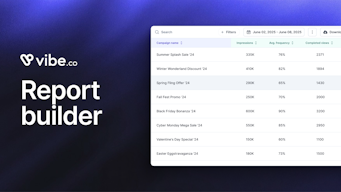Best CTV Advertising Examples for 2023
Streaming television advertising, also known as CTV advertising, has hit its stride in 2023 as advertisers and viewers alike adapt to a new media consumption model. To viewers of course, CTV is still just TV, as they continue to watch their favorite shows, some of them increasingly accompanied by ads like it’s 1999 all over again! What’s the saying? “Everything old is new again”? Well, pretty much. On the advertisers’ side, however, it’s a brave new world. Here’s how it all got started.
What is CTV advertising?
Connected TV streams premium, long form content over the internet and delivers it to viewers’ homes either directly through an internet-enabled TV or thanks to a connected device like a Roku or Amazon Fire dongle. It stands in contrast to traditional or “linear” television which encompasses broadcast and cable programming. While this technology was already developing a tech-savvy audience before 2020, the pandemic launched on-demand streaming into the stratosphere. Today, 92% of US households own at least one connected device and streaming viewership has officially surpassed linear.
Meanwhile, what started as a boon for viewers (premium, on-demand, bingeable content) has turned into an equally exciting opportunity for advertisers, as AVOD (Ad Supported On Demand) streaming services become ubiquitous and viewers grow to accept (even prefer?) ads as long as they help them lower their monthly streaming budget and remain relevant to their interests. FAST (Free Ad Supported TV) are the fastest growing digital channel by far this year, as price-conscious customers drop their expensive subscriptions, affording advertisers an entirely new way to target engaged audiences.
How does CTV advertising work?
CTV ads are unskippable, unmutable, and targetable, affording them a whopping 97% average VTR (View Through Rate). Here’s how it works: without worrying about cookies or signal loss (unlike our friends over at Meta and Google), CTV ad platforms can target household IPs, segmented by dozens of dimensions, including search queries, household income, demographic, location, political affiliation, and more, drastically reducing wasted impression rates. This level of granular targeting coupled with premium creative formatting ensures audience engagement will be at its highest when encountering a streaming ad.
On the flip side, advertisers can deploy pixel tracking and MMP (Mobile Measurement Partner) integration to monitor conversions and leverage retargeting strategies in real time. That’s right: advertisers working with the right CTV ad partner can retarget their customers and site visitors directly on their TV screens. In fact, that’s where CTV advertising shines the brightest - as a performance accelerator for other channels. Not only can CTV advertising demonstrably lead to direct conversions, it also improves results on display, social, foot traffic data, and more.
How much does CTV advertising cost?
Arguably the largest obstacle facing most brands wishing to advertise on television, however, remains cost. That’s why CTV advertising is such a significant industry disruptor: programmatic media buys are conducted on CPM (cost per thousand impressions) basis, allowing advertisers to pay only for the targeted impressions they want - no upfront contracts or fees to worry about.
Average industry CPMs still vary widely, typically garnering higher prices for tighter targeting dimensions and decreasing for broader reach and open programmatic channels. For example, a self-serve platform like Vibe.co allows advertisers to place targeted ads across their inventory of 500+ channels for CPMs hovering between $12 and $22. A “walled garden” service like Netflix, on the other hand, will charge advertisers CPMs starting at $60. Woah! Whichever way advertisers decide to go, the goal remains the same: create a compelling, relevant ad that will drive campaign performance. Here are some tips to help you get there.
Best Practices
Although recent industry disruptions have revived the debate around what constitutes “the best” TV commercials, hallmarks of strong contenders include a compelling premise, a strong stance, emotional resonance, and the ability to spark action. Keeping in mind that these best practices are meant to help advertisers hungry for performance-focused TV campaigns with a solid ROI, here are the most successful CTV ad creation strategies today.
Customize
Ad set targeting and customization is where Connected Television advertising can really shine. Study after study has shown that consumers are perfectly willing to watch and engage with ads as long as they are relevant to their needs and circumstances. Advertisers working with full service CTV ad platforms like Vibe.co are able to dynamically insert location or demographic specific details in their videos and deploy them according to relevant targeting dimensions. You would be surprised what an extra shot of a local landmark or community organization can do for brand recall and loyalty.
Get to the point
In the 1970s, consumers saw around 500 ads per day. Today, consumers are exposed to anywhere from 6,000 to 10,000 ads daily. No wonder they can’t pay attention! A recent Digiday study reports the average viewer loses interest after 8 seconds of an ad, with Gen Z losing focus after only 1.3 seconds! That means advertisers need to get to the point in the very first few seconds of their ad. No gimmicks, no long build up.
Get bossy
Viewers won’t engage with your ad the way you want them to unless you tell them how. Pick one clear CTA (Call To Action) to have on-screen for most if not all of your creative and repeat it in voiceover or in the video. Make it easy to convert with campaign-specific QR codes or special deals.
Pull at the heartstrings
While it’s important to craft a brief, clear, actionable message, television remains the best storytelling tool in the industry, by a mile. Advertisers should keep in mind that their ad will play next to premium content and needs to live up to that high quality format. There’s no better way to create a lasting, trusting relationship with customers than with some good old fashioned storytelling. Some great ways to engage audiences emotionally include employee spotlights, customer testimonials, founder origin stories, community sponsorship highlights, etc.
Set yourself up for tracking success
The ease with which advertisers can now launch and optimize TV ads today can feel magical, but it’s important to set up measurement tools on the front end to ensure long-term success. There are many ways to measure performance, depending on your goals, but some simple options can include:
- Pixel tracking running campaigns
- Pixel tracking web visits to enable retargeting
- Google Analytics integration
- MMP (Mobile Measurement Partner) integration
- Real-time campaign optimization
Make sure to have these tools in place before launching any CTV campaign.
Now let’s have a look at how some of our favorite advertisers have made the most of these recommendations.


